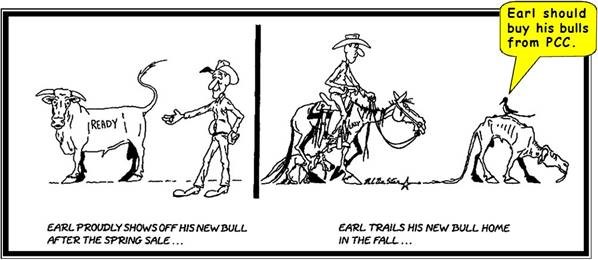Kit Pharo regularly shares the cartoon I’ve included below of Earl and his new bull. I always get a kick out of it and think how unfortunate that situation would be, but I assumed it was clearly a bit exaggerated. That was until I had an eerily similar experience buying my first bull.

When I graduated college in the fall of 2014, I bought 23 registered Polled Hereford cows. They were low-input PCC genetics, just like the Red Angus cattle my family had been raising for decades, but I wanted to start a herd of my own. I was 22 years old and still had six months left of college. Fortunately, I did not have any student loan debt, but I did not have the cash to purchase those heifers, so I used debt to purchase them at what turned out to be the peak of the cattle market. But that’s another learning lesson for another day. Obviously, the next thing I needed to complete my herd was a top-notch herd sire. I went through the PCC sale catalog and wouldn’t you know it, one of the best Hereford bulls I’d ever seen was for sale that very spring. The bull’s name was Axel. Sale day came, and Axel sold for over $10,000… to somebody else. As a beginning farmer, still in college, with a pile of debt and a low income, I didn’t feel I could afford him.
I ended up buying a local bull for $2,800. He looked fantastic, and when I talked to the owner, he said the only problem with the bull’s mother was that she might be too short. Well, I believe in moderate-framed cows, so this sounded like a good thing to me! The bull was moderate, thick, and looked solid. I thought I had gotten a real steal on a good local bull. However, the bull had been developed on grain.
As soon as I got my new bull home and turned him out to pasture with our grass-based Red Angus herd sires, he started melting away. Before long, he looked terrible! I would have been better off using one of the Red Angus bulls as a cleanup bull. Fortunately, I was able to use Axel as my AI sire. That gave me the opportunity to see a side-by-side comparison of the calves sired by a grass-developed bull and a traditional feedlot-developed bull, all managed under a low-input, grass-based system.
Not one of the heifers out of the bull I purchased made it into the cowherd, and none of his sons were the right type or quality to make it into a PCC bull sale. Axel only sired one heifer calf that first year, and she was in the herd for several years until I sold the Herefords. All of the Axel-sired bull calves made it into the bull sale.
I sold the bull to a buddy of mine who feeds grain, where both he and his calves would be a better fit. Below is a picture of him at my friend’s place. Compare that to a picture of Axel at about the same age.

Whenever I see the “Earl’s New Bull” cartoon, I am reminded of this experience. Honestly, I consider myself lucky to have had this experience early on. It showed me just how important it is to use genetics that were developed in a production model that aligns with yours and to build a herd that thrives in your environment.